

Table of contents
- Choosing the right tree
- Trees from A – B
- Shade trees with E
- G – H
- Shade provider from K – L
- Big trees from P – S
- frequently asked Questions
Sunny gardens often need a shade tree. Depending on the space available, a house tree is well suited for this. This article explains which trees are suitable for this and what should be taken into account when choosing.
Choosing the right tree
There are a few things to consider when choosing the right shade tree or trees. Last but not least, the size of the fully grown tree is of great importance. This doesn’t just apply to small gardens. Demanding care also plays a role. Other possible criteria:
- Shade only in summer or also in winter?
- Suitable as a privacy screen?
- Interested in picking your own fruit?
- How much time can be spent on tree care?
- Native or exotic tree?
Trees from A – B
maple (Acer)
The special thing maple trees is the very decorative coloring in autumn, which can range from golden yellow to deep red. Most maple species are hardy and are therefore well suited as a shade tree for the garden.

- growth: shrub-like varieties to large trees up to 30 m high
- Characteristics: Leaves palmately lobed, flowers inconspicuously in spring, typical fruits with wings, shallow roots
- Location: mostly undemanding, do not plant in the shade, soil is permeable and nutrient-rich
- Care: mulch, otherwise easy to care for
- cut: not necessary
- Species/Varieties: field maple (Acer campestre, suitable for hedges), Globe maple (Acer platanoides 'Globosum', small-crowned), Japanese maple (Acer palmatum, from Asia, particularly attractive)
Birch trees (Betula)
Most birch trees can be recognized from afar by their distinctive white-black bark. There are many species that are suitable as shade trees in the garden.
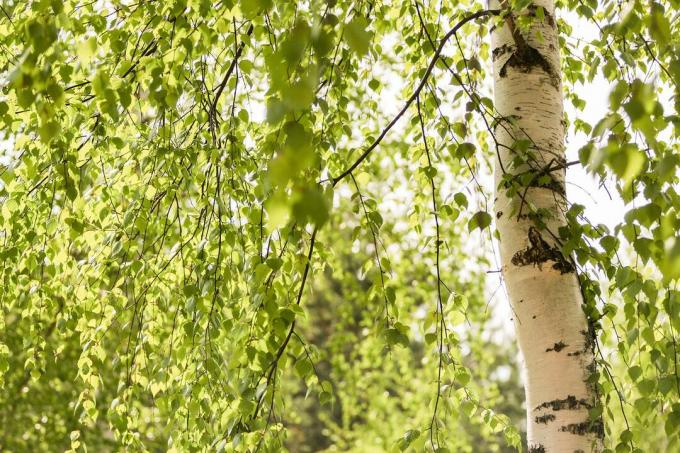
- growth: upright, loose crown formation, up to 30 m high
- Characteristics: deciduous, hanging shoots, hardy, fast growing
- Location: sunny to partially shaded, nutrient-rich, soil that is not too dry
- Care: robust and easy to care for, water young trees from time to time
- cut: not necessary if in the fall
- Species/Varieties: Silver or white birch (Betula pendula, hanging shoots, native), Himalayan birch (Betula utilis, white trunk), copper birch (Betula albosinensis, copper-colored bark, rolls off in strips)
Book (Fagus)
Beech trees are often planted as hedges in the garden, but they are also suitable as shade trees. In autumn they produce edible fruits, the beechnuts.
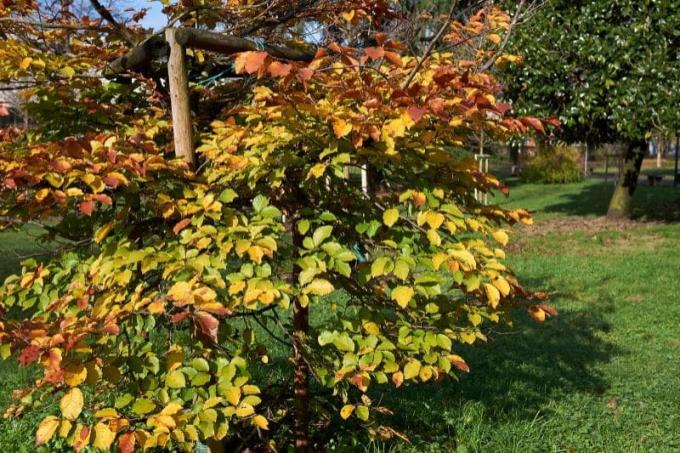
- growth: upright, up to 30 meters high, spreading crown
- Characteristics: smooth, gray bark, hardy, foliage colored bright red depending on the variety, fast growing
- Location: sunny to shady, no waterlogging or extreme dryness
- Care: uncomplicated, water when it is dry, do not pile up soil in the root area
- Harvest/cut: tolerates pruning, not necessary for trees, beechnuts fall to the ground on their own in autumn
- Species/Varieties: European beech (Fagus sylvatica, red leaves), weeping beech (Fagus sylvatica pendula, hanging shoots, cemetery tree)
A notice:
Contrary to what the name suggests, the hornbeam (Carpinus betulus) does not belong to the beech family, but to the birch family.
Shade trees with E
Oaks (Quercus)
Oak trees can grow very old and develop a very large crown over time. Oak leaves can be a problem in the garden because they only decompose slowly.

- growth: often short trunk, richly branched crown, up to 35 meters high
- Characteristics: deciduous, hardy, forms acorns, typically lobed leaves, deep-rooted, slow-growing
- Location: warm, sunny if possible, otherwise undemanding
- Care: easy to care for, mulch young trees and water them when dry
- cut: Remove dead wood
- Species/Varieties: sessile and common oak (Quercus petraea and Q. robur, native), red oak (Quercus rubra, North America, red autumn color), valley oak (Quercus lobata)
alder (Alnus)
The alder is suitable as a shady tree for rather damp garden areas, for example near a pond. The fruits that form in autumn are often used in autumn and Christmas floristry.
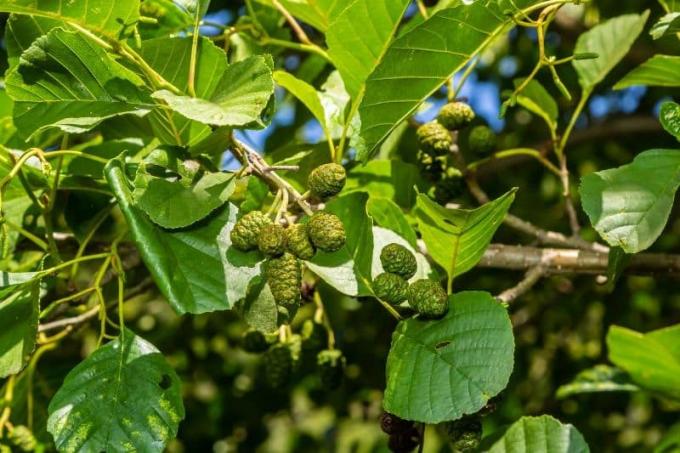
- growth: spreading, loose crown, often growing with multiple trunks, up to 30 meters high
- Characteristics: fast growing, forms small black cones in autumn,
- Location: sunny to partially shaded, permeable, nutrient-rich moist soil
- Care: water when dry
- cut: Carry out plant pruning or have it done, otherwise hardly necessary
- Species/Varieties: Black alder (Alnus glutinosa), gray alder (Alnus incana), green alder (Alnus viridis, shrub-like)
Ash (Fraxinus)
The ash tree also prefers damp locations. As it ages, it often forms a lot of dead wood, which should be removed regularly.
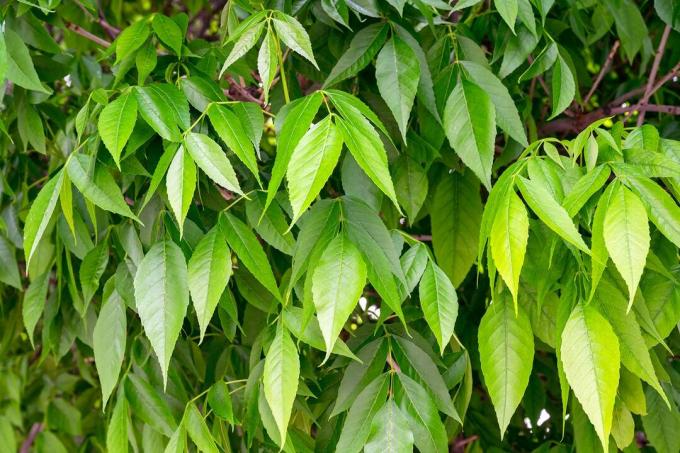
- growth: tall deciduous tree, spreading crown, up to 30 meters high
- Characteristics: hardy, deciduous, fast growing, leaves imparipinnate
- Location: sunny to partially shaded, not too dry, protected from wind
- Care: easy to care for, water young trees when it is dry
- cut: not necessary
- Species/Varieties: Common ash (Fraxinus excelsior, native), flower ash (Fraxinus ornus, slow growing, up to 8 m high), ball ash (Fraxinus excelsior 'Nana', only up to 6 m high)
A notice:
Ash trees are sometimes affected by ash dieback, a disease that can quickly kill the tree.
G – H
ginkgo (Ginkgo biloba), Fan leaf tree
The ginkgo originally comes from East Asia, where it was often used as a temple tree. In Europe it was first planted in parks as an ornamental tree.

- growth: upright, Slender shape, up to 40 meters high, few branched crown
- Characteristics: fan-like leaves, yellow autumn color
- Location: sunny to partially shaded, nutrient-rich, deep, loamy soil
- Care: Protect from drying out with a layer of mulch and protect the trunk from frost cracks
- cut: To improve branching, shorten young trees on the outside of the crown
- Species/Varieties: 'Aurea' (yellow leaves), 'Pendula' (drooping shoots), 'Tremonia' (narrow growth)
elder (Sambucus)
Although elderberries are shrubs, they can be trained into small, shade-casting trees. They bloom white in spring and produce red or black berries in autumn.

- growth: shrub-like, multi-stemmed up to 6 meters high, overhanging crown
- Characteristics: Leaves are pinnately pinnate, tree sometimes produces an unpleasant odor
- Location: partially shaded, nutrient-rich, moist, well-drained soil
- Care: do not let it dry out
- Harvest/cut: Harvest the berries as soon as they are completely colored, seevery compatible with cutting, can be easily cut into shape, but cutting is not necessary
- Species/Varieties: Black elderberry (Sambucus nigra, edible berries after cooking), red elderberry (Sambucus racemosa)
Shade provider from K – L
Chestnuts (Castanea)
The fruits of the native horse chestnut are not edible, but are very popular with children in autumn because they are good for crafts and decoration.

- growth: spreading crown when old, up to 30 meters high
- Characteristics: fast growing, palmately pinnate leaves, fruits in a spiny shell
- Location: sunny to partially shaded, permeable, nutrient-rich soil
- Care: fertilize in spring, protect from frost cracks
- Harvest/cut: Chestnuts fall to the ground at the end of September to October, not very compatible with cutting, avoid major cutting measures
- Species/Varieties: Common horse chestnut (Aesculus hippocastanum, not edible), chestnuts (Castanea sativa, edible, chestnuts)
pome fruit (Pyrinae)
Pome fruit is suitable for providing shade in the garden if it is a standard tree. They also have the advantage that they are easier to work with. However, harvesting and working on the tree are more difficult with tall trunks.
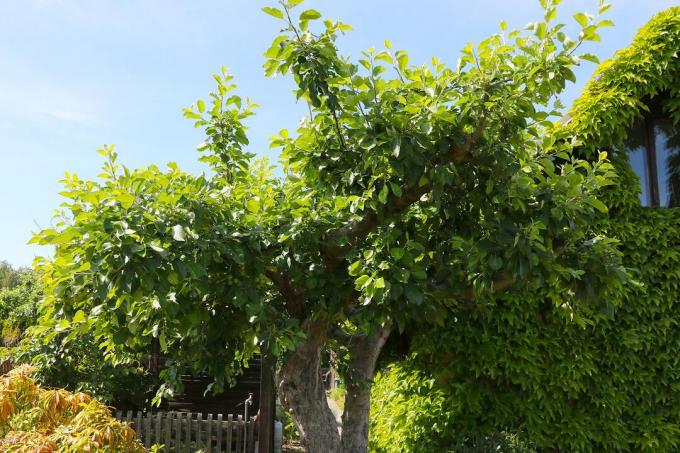
- growth: upright, loose crown, quince rather bush-like, standard trunks up to 10 meters high
- Characteristics: fast or slow growing depending on the rootstock, hardy
- Location: sunny to partially shaded, protected, well-drained, not too dry soil
- Care: fertilize in spring, water when dry, protect trunk from frost cracks
- Harvest/cut: Fruits ripen from late summer to late autumn, regular pruning is necessary for a good yield
- Species/Varieties: apple (Malus sylvestris), pear (Pyrus communis), quince (Cydonia oblonga), rowan (Sorbus aucuparia, rowanberry)
Linden (Tilia)
When the linden trees bloom in midsummer, this can be recognized from afar by their typical scent. A tea can be made from the flowers and is said to have healing properties.

- growth: upright, rather short trunk, crown up to 40 meters high
- Characteristics: heart-shaped leaves, flowers with a strong scent, important pasture for bees
- Location: sunny, well-drained, nutrient-rich, not too dry soil
- Care: easy to care for, only water young trees in dry conditions
- cut: very easy to cut, can be cut into any shape to provide shade
- Species/Varieties: Summer and winter linden trees (Tilia platyphyllos and T. cordata)
Big trees from P – S
plane (Platanus x hispanica), Maple leaf plane tree
The plane tree is often planted as a city or street tree, but can also be used as a shade tree in larger gardens. Your crown can be shaped into any shape you want.
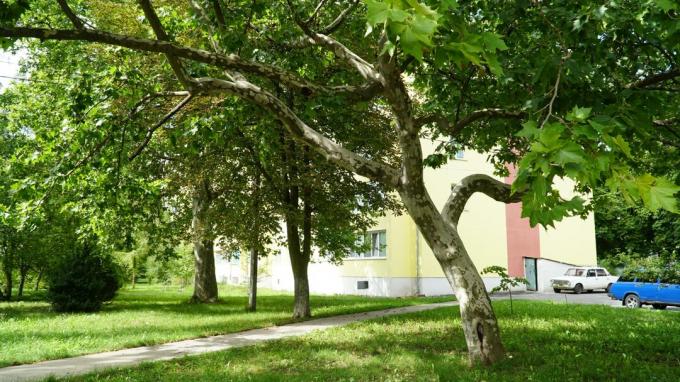
- growth: upright, spreading crown, up to 30 meters high
- Characteristics: deciduous, hardy, maple-like leaves, typically peeling bark
- Location: sunny to partially shaded, well-drained, moist soil
- Care: easy-care, water moderately in dry conditions, protect young trees from severe frost in winter
- cut: cut back in winter, very tolerant of cutting
- Species/Varieties: 'Tremonia' (up to 20 m high, slender growth habit, 'Alphens Globe' (spherical crown, up to 5 m high)
stone fruit (mainly Prunus)
There are many different types of stone fruit, the larger ones of which are suitable as shade trees for the garden. Standard trunks are particularly suitable if the yield of the trees is not that important.

- growth: upright, some with a sprawling, dense crown, up to 20 meters high
- Characteristics: deciduous, wild forms well suited as bird food
- Location: sunny to partially shaded, protected, nutrient-rich, not too dry, permeable soil
- Care: fertilize in spring, water in dry conditions, protect from frost cracks
- Harvest/cut: Harvest ripe fruits from early summer to autumn, regular cutting is necessary for high yields
- Species/Varieties: plum and plum (Prunus domestica), bird or Sweet cherry (Prunus avium), sour cherry (Prunus cerasus)
frequently asked Questions
Depending on the specific tree species, the crown can be cut back. Felling old trees is often not possible without permission and should only be considered as a last option.
In addition to regional collection points, there are other options for disposing of the leaves. On the one hand, it can be added to the compost, where it decomposes and can be used as fertilizer. However, oak and walnut leaves decompose poorly and contain a lot of tannic acid. On the other hand, the leaves, together with some brushwood, can also remain in sheltered places in the garden where they serve as shelter for animals.
For young trees, the tree disc should be left free and only mulched. Various plants can later be planted under the tree, taking care not to damage shallow roots when planting. The plants selected should be able to cope with the conditions under the tree and not compete with the tree.
 Mandy
Mandy
Learn more about garden design

Support the embankment with formwork stones
Supporting a slope with formwork stones is a stable and long-lasting solution. However, there are a few important points when setting up that must be taken into account to ensure a high level of security. This includes, for example, the correct procedure for laying the foundation.

Filling gabions: stones, wire thickness & sizes
Due to their properties, gabions are one of the most popular fencing and wall alternatives. Choosing the right size and wire gauge is essential for successful installation. so that they can be filled easily and do not bulge or bulge under the weight of the stones fall over.

Labeling stones in a weatherproof way – this is how you can do it on stone + slate
Labeling slate and stone in a weatherproof manner is actually quite easy if you have the right knowledge and the right tools. Here we reveal how it works and what is needed for it.
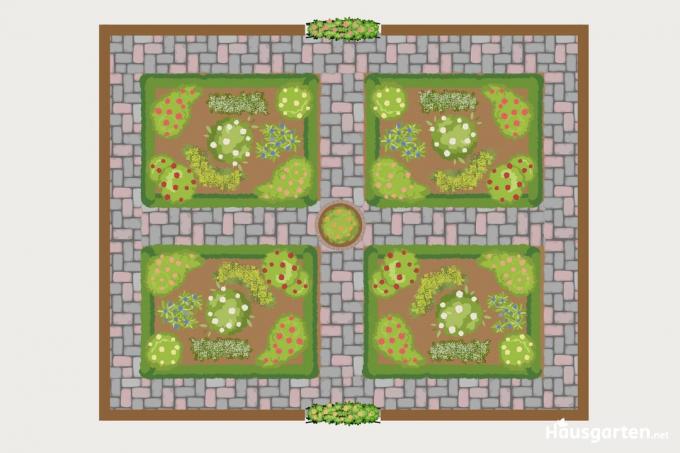
6 ideas for designing rose beds – planting plan & ideas for rose beds
Is it high time for your garden to be woken up by the queen of flowers? Then let yourself be inspired by 6 ideas for an imaginative design of rose beds. Tangible planting plans demonstrate in detail how you can stylishly turn romantic flower dreams into reality.

Easy-care slope planting for sunny locations – plant slopes
A decoratively designed slope is not only a visual eye-catcher, but can also be extremely easy to care for. Find out here which plants you can use to turn your sunny slope into a decorative highlight!

Create a snack garden in the garden and on the balcony
A snack garden can be found in the smallest garden. Even balconies and terraces offer space for a few selected plants from which fruits can be eaten, not just by children. The location and an appropriate planting substrate are important.



